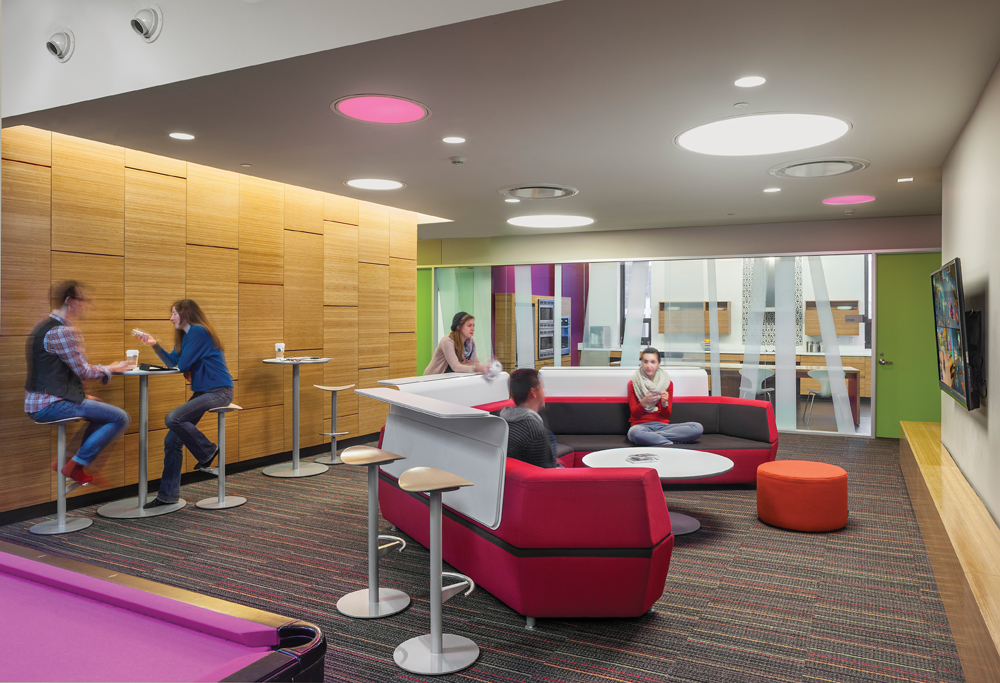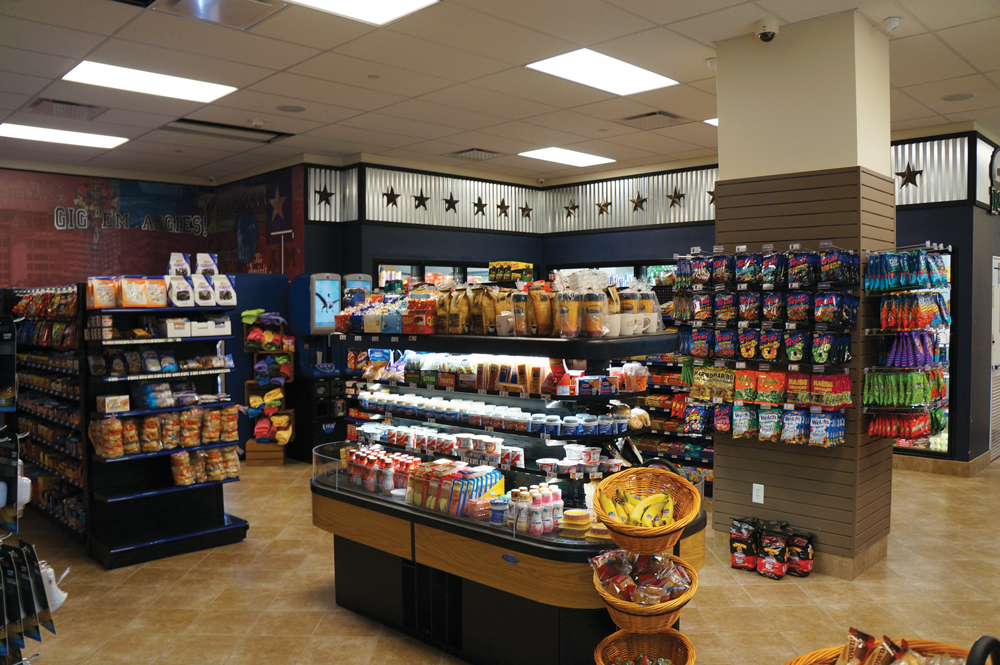Until recently, the most important thing college students wanted in on-campus housing was privacy—private bedrooms, private baths, private this, private that. In the race to attract students, colleges and universities did their best to create living spaces that tried to fulfill that wish.
The resulting boom in suite-style housing—with private bedrooms, common living rooms, and bathrooms shared by two, three, or four suitemates—delivered as much privacy as most colleges could afford to provide. But the emphasis on privacy carried with it the potential to foster isolation among students, particularly if the residence hall had limited common areas for socializing.
Today, college facilities directors are rethinking certain assumptions about campus living spaces. Some are reverting to an older university housing model: double rooms with bathrooms and common areas shared by larger groups of students. Students themselves are coming around on this approach, albeit slowly. Dennis Lynch, Associate Principal at Baltimore design firm Ayers Saint Gross, recalls one college senior he met at a design roundtable. The student had spent his entire college career in a suite-style building with no shared lounge space. “He said, ‘I made a mistake. I only got to know my suitemates,” said Lynch. The student regretted not having tried a traditional unit during his college career.
Universities are using residence halls to:
1. Foster a sense of community on campus.
2. Gain other benefits by downsizing bedrooms.
3. Create uncommonly vibrant common areas.
4. Figure out how best to use technology.
5. Blend academics with living spaces.
6. Compete for students.
This is not to imply that suite-style spaces are a thing of the past. They are still being built. But institutions of higher learning are looking for student housing designs that create greater opportunities for students to interact with each other, thereby fostering a closer sense of community.
Residence hall design is also being jolted by technology. Mobile computing, ubiquitous Internet connectivity, and distance learning—including MOOCs, or massive open online courses—are having a profound effect on how, when, and where students learn. College classrooms and libraries were the first building types to feel the brunt of this technology; now, it is the residence halls’ turn.
How these factors will impact the college experience for current and future students is not entirely clear. To gain perspective, let’s take a look at how college capital expenditure administrators and their Building Teams are responding to a fresh set of parameters in the design and construction of new and renovated campus housing.
1. Universities are using residence halls to foster a sense of community on campus.
University officials and design firms are struggling to understand how rapidly changing student habits are altering how they use living spaces. To get a better feel for that phenomenon, Little Diversified Architectural Consulting earlier this year conducted a daylong student housing symposium at its Durham and Charlotte locations to pick the brains of 62 students from a dozen North Carolina institutions.
“We were surprised at how much time students are spending in housing facilities,” says Thomas Carlson-Reddig, AIA, LEED AP, Global Practice Leader for the firm’s Community team. The discussion revealed that half the students surveyed studied in their rooms, while half “escaped” to other spaces to study, eat, and relax.
New and renovated housing projects are offering a variety of common areas—lounges, seminar rooms, game rooms, and other socially oriented amenities, such as nooks with plush seating—for just this purpose. Others are introducing design features that open up the opportunity for students to run into each other and engage in conversation and interaction—provided, of course, that their heads aren’t buried in their iPhones.
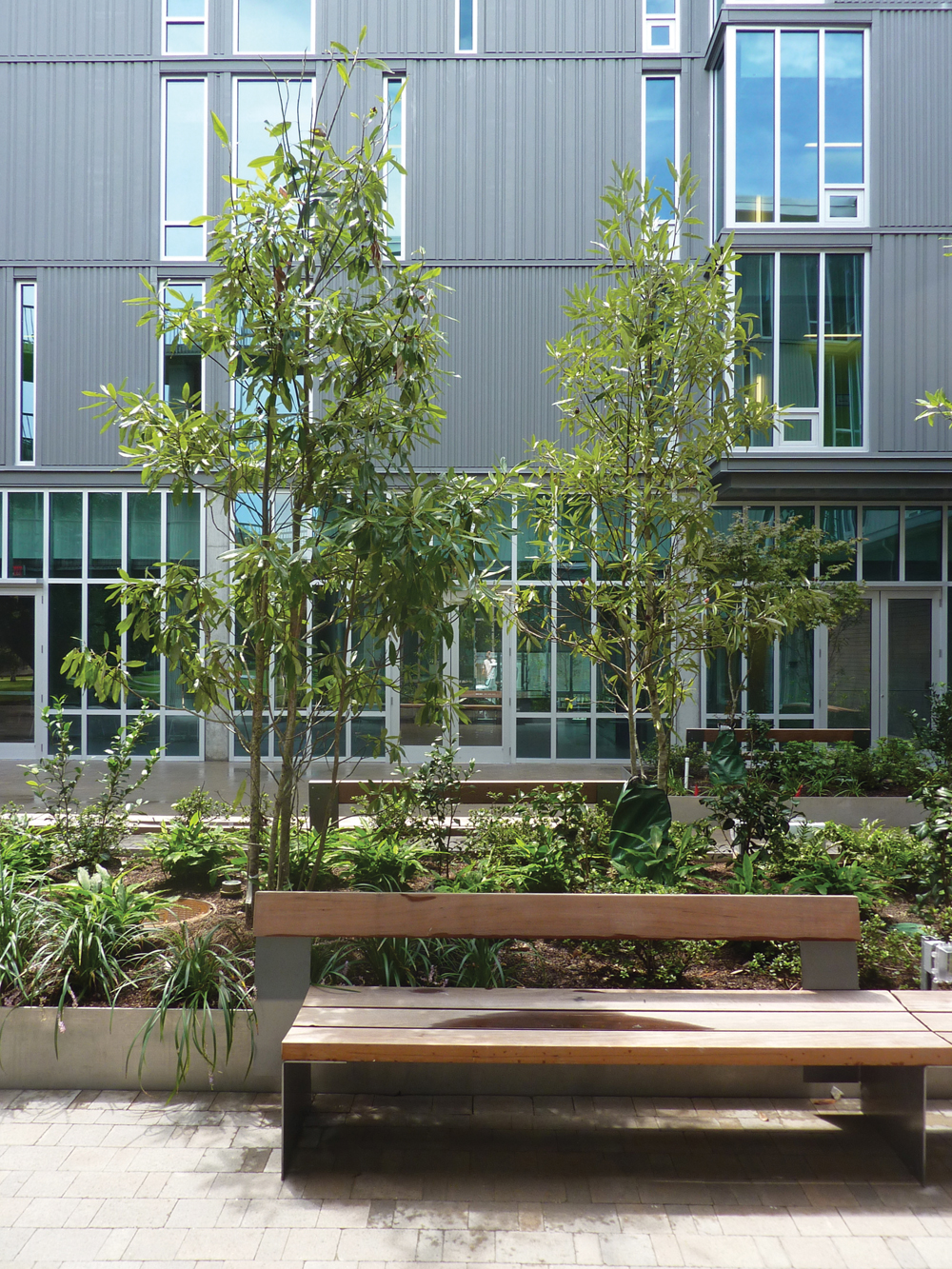
Barbara Greenbaum House, a new six-story, 256-bed student residence at Tulane University, New Orleans, completes a quadrangle formed by two 1912 buildings designed by James Gamble Rogers. On track for LEED Gold, the 78,930-sf building has apartments for a faculty-in-residence and house director. Architecture Research Office led the Building Team of Waggonner & Ball Architects (collaborating architect); Schrenk, Endom & Flanagan (SE/CE); Huseman & Associates (MEP/FP); Threshold Acoustics (acoustics consultant); Tillotson Design Associates (lighting design); Towers|Golde Landscape Architecture & Site Planners; Thompson Building Energy Solutions (Cx agent); and The Lemoine Company (GC). Photo: courtesy Architecture Research Office
At Tulane University in New Orleans, Barbara Greenbaum House, a new 256-bedroom residence hall, features a multi-level bridge that connects the two main wings of the building. The bridge is glazed from floor to ceiling with views of an outdoor courtyard. On three floors, the bridge forms a terrace adjacent to social spaces, providing another locus for small groups to congregate. The transparency provided by the generous use of glass allows students to see friends from a distance in either the courtyard or social lounge. More informal socialization is thus enabled.
Many common areas have been opened up via transparent doors and panels, even in laundry rooms—spaces that used to be hidden in basements. “The idea of isolation is fading away,” says B.K. Boley, AIA, LEED AP, Principal and Director of Academic Practice at design firm ADD, Inc. Even bathrooms are getting this kind of treatment. “We’re doing more community baths for freshman and sophomores, particularly in the Northeast,” says Boley.
Holding down costs is the primary motivator for shared bath facilities. To forestall complaints from students (and their tuition-paying parents), these community baths tend to have higher-end finishes and are equipped with dressing stalls directly adjacent to showers—putting them a grade above so-called “gang bathrooms” of yore.
Design features that reduce isolation and promote socialization are also helping resident assistants gain more opportunities to interact with their charges. This is particularly important for RAs who are responsible for freshmen. “If a new student is having problems adjusting to college life, the RA is more likely to identify issues before they become more serious” if there’s more interaction, says Ayer Saint Gross’s Lynch.
2. Universities are shrinking residence hall bedrooms to gain other benefits.
One increasingly popular—but by no means universal—tactic to fit more expansive social areas into tight budgets is to downsize student bedrooms. “Rooms are getting smaller so shared spaces can get bigger,” says ADD’s Boley.
How small? Lisa Ferreira, AIA, LEED AP, Associate Principal at Boston design firm Goody Clancy, says 180 sf for a double is “the low end of comfortable.” More typical is 200-240 sf for doubles; about 125 sf for singles, she says.
Little’s design for the renovation of a College of Wooster (Ohio) residence facility made use of high ceilings to make small bedrooms seem less cramped. This adaptive reuse project of a historic 34,000-sf former elementary school building—Gault Schoolhouse, most recently used by the college for offices—created suite-style living for 74 seniors. Each suite has single or double pods—sleeping quarters and storage space of 72 sf (single) and 109 sf (double). Little took advantage of the old schoolhouse’s 12-foot-high ceilings to overcome the claustrophobia that might come with eight- or nine-foot ceilings. The extra volume allowed the beds to be elevated to provide ample closet and storage room below the beds.
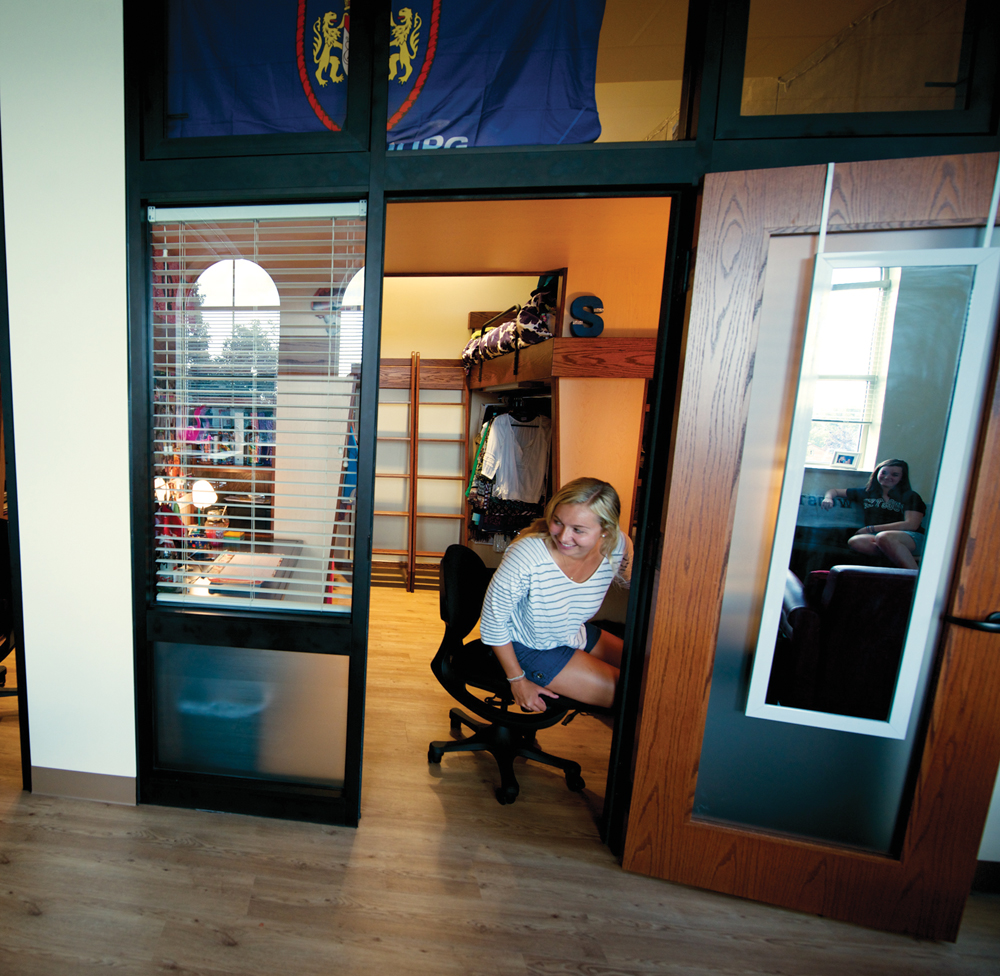
A student bedroom at the College of Wooster (Ohio) capitalizes on 12-foot-high ceilings to optimize overhead storage space, extra sleeping area, and daylighting. The conversion of the 34,000-sf former elementary school/office space was designed by lead architect Little, with BSHM/Balog Steines Hendricks & Manchester Architects (AOR) and Karpinski Engineering (MEP). Bogner Construction Co. was the GC. Photo: courtesy Little
A crow’s nest platform at the foot of each bed provides additional storage space; it can even be a makeshift sleeping quarters for a moderately sized overnight guest. A small window adjacent to the crow’s nest overlooks the shared living room area, allowing even more light to flow into the bedroom. The windows can be opened manually for ventilation and more efficient heating and cooling. Translucent frosted glass doors—a student-suggested touch—also bring light into the bedrooms and make the space feel more open.
Though this adaptive-reuse project is something of a rarity, Little’s Carlson-Reddig believes that its design concepts can be applied more broadly. “We think the verticality of the design can translate to new buildings,” he says. In locations where square footage is limited by site restrictions, the solution may be to build higher inside and out.
3. Universities are creating residence hall common areas that are uncommonly vibrant.
Advances in technology are energizing the design of common areas in residence halls. Mobile computing and Wi-Fi connectivity are taken for granted. Smartphones, laptops, and iPads make every space a potential study nook. “The use of technology is blurring the lines between living and learning,” says Adam Yarinsky, FAIA, LEED AP, Principal with Architecture Research Office, in New York. Study areas no longer require lots of desks or tables; plush sofas and chairs will do nicely, thank you.
The original design for the adaptive reuse of the Gault Schoolhouse residence hall at the College of Wooster called for traditional study carrels in a lower-level common room. After hearing from students, designers at Little turned the room into a homey chill space with sofas, exposed brick walls and wood beams, and natural light. Students are using the room for studying, watching videos, chatting with friends, and impromptu meetings—the kind of social interaction that Dean of Students Kurt Holmes dreamed the renovation would produce.
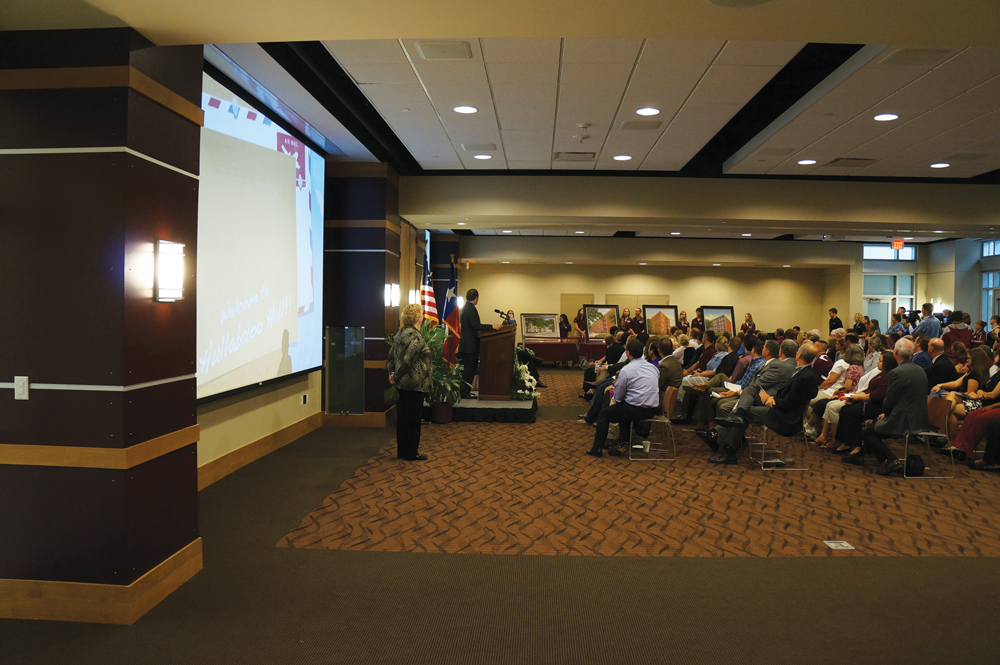
Texas A&M’s Hulabaloo Hall features a convenience store (top) and multipurpose academic room (bottom). The five-story, $66 million, 648-bed facility is the first new residence hall on the Aggie campus since the 1980s. Treanor Architects (design architect) and Stantec (prime architect) led the Building Team for owner/PM Texas A&M University Facilities, Planning & Construction/HUB. Rounding out the team: Structures + Haynes Whaley (SE); Kimley-Horn and Associates (CE); H2MG (MEP); Terracon (geotechnical, materials testing); Coleman|TBG (landscape architect); Siemens Energy Management (energy systems); Horizon (Cx agent); and Linbeck (CMAR). Photo: Luis Ayala / courtesy Stantec
Designers are starting to see hallways as social spaces, not just conduits. Instead of long, artificially lit corridors, they’re bringing in daylighting from extensive exterior glazing into hallways and creating nooks and crannies for students to use as impromptu study areas, or just to chill. Small cell phone rooms are popping up along hallways, where students can get some privacy to make calls of a sensitive nature. These modern-day versions of Ma Bell phone booths typically have transparent doors and floor-to-ceiling glazing to allow that always-welcome daylight to pass through.
Some colleges are experimenting with innovative common areas to provide enriching learning experiences. Demonstration kitchens within multi-purpose spaces have been featured in a few new residence halls, including those at Tulane University and Worcester (Mass.) State College. They can be used for cooking workshops or special events, such as a demonstration by a local chef. At Massachusetts College of Art and Design in Boston, the Tree House residence hall has an art gallery where students program the exhibits.
Common areas are being viewed more and more as prized amenities central to the quality of life on college campuses. The key question is cost. “Universities are trying to figure out what is the sweet spot for net square feet of common area space per bed,” says Goody Clancy’s Ferreira.
4. Universities are struggling with how best to use high-tech systems in residence halls.
Schools are grappling with the problem of how to accommodate distance learning. Some universities provide space within residence halls, but there’s no consensus on how these rooms should be designed. “A flat screen in a classroom is not necessarily the solution,” says Michael Romot, AIA, NCARB, LEED AP BD+C, Project Manager with Little. Other options could include the creation of living units with even more learning environments within the housing facility—“live-study environments like a mixed-use development within the campus,” says Romot.
One former universal residence hall amenity—the dedicated computer lab—is going the way of the dodo. Students have their own electronic devices; they don’t want the school to dictate what to use. Their computer lab is on their smartphones.

Two views of the Warren and Moore Residential College Complex, including the Kissam Center, at Vanderbilt University, Nashville. The 395,000-sf, LEED Gold complex provides housing for about 660 students in a “residential college” setting, with graduate fellows in each college. The Kissam Center provides gathering space, dining facilities, a classroom, offices, and meeting rooms. The Building Team: Goody Clancy (architect); EOA Architects (associate architect); Weidlinger Associates (SE); Barge Cauthen & Associates (CE); Smith Seckman Reid (MEP); greenStudio (sustainability consultant); and Brasfield & Gorrie (GC). The university acted as its own landscaping contractor. More than 80% of the demolition waste—21,000 tons—from the old Kissam Quadrangle was diverted from landfill. More than 90% of regularly occupied spaces have a direct line of sight to the outdoors. Photo: Nick Weidemann
The exception that proves the rule: Texas A&M University’s new Hullabaloo Hall, which melds housing with an extensive Community Learning Center. “It’s like a library without books,” says Chareny Rydl, the Aggies’ Director of Residential Life. The first-floor facility employs an open office design concept. “Students don’t want the old structure of computer labs with cubicles that make you feel boxed in,” says Rydl.
The Community Learning Center also provides learning opportunities for students living in other residences. says Rydl. The space has individual and group study areas and is equipped with high-end computers with access to special engineering programs and other expensive software that most students can’t afford. “We track who uses the space,” she says. “We were surprised to see people from other parts of the campus using it.”
5. Universities are blending academics with living space via the ‘residential college.’
The concept of the residential college, where guided learning occurs largely within the residence facility, continues to grow in influence, even at institutions that don’t formally adopt it. Classrooms and multi-purpose rooms with movable furniture and partitions that can be arranged like classrooms and lecture halls are desirable features in some residence halls.
At Tulane University, a recent convert to the residential college format, the Greenbaum building includes an apartment for a faculty-member-in-residence and an office for a full-time community director responsible for programming activities and overseeing quality of life for the residential college and its nearby residence. Greenbaum’s common areas are the setting for most of the residential college’s events.
Vanderbilt University is also transitioning to a residential college format, with more new housing planned to support the effort. “The timetable is dependent on fundraising,” says Bob Grummon, CSI, LEED AP, Project Manager at Vanderbilt. Renovations are planned, although some older structures may not be suitable to the residential college format.
“The key question is how to get more community space,” says Grummon. The university wants to mix in suite-style housing with more traditional single and double rooms in each residential college. Existing structures will have to be able to accommodate such conditions at a reasonable cost for this to work.
6. Universities are looking for the next generation of on-campus living—and over their shoulders at the competition.
With campus housing design in flux, some schools are already thinking ahead a few decades about possible major renovations of recently completed residence facilities. It’s difficult to predict what the residence hall of 30 years from now should look like, Rydl says, so the wisest course of action is to leave future housing directors with buildings that can be extensively revamped.
Many have common areas with large, open spaces that could easily be repurposed to meet tomorrow’s needs. Texas A&M’s Hullabaloo Hall was structured in such a way that gut renovations could be done cost effectively as needed in the future.
Some institutions already find themselves competing against newer off-campus options with high-profile amenities. In Raleigh, N.C., home of North Carolina State University, Stanhope Student Apartments—“The Ultimate in Student Living,” according to its website—is accepting applications for summer 2015 occupancy. Amenities include an oasis saltwater pool with splash deck, outdoor courtyards with televisions, fire pits, grills, art studio, two-story game room, fitness center, and two tanning rooms.
Stanhope’s website makes no bones about being right next to the N.C. State campus and “right above brand new retail, restaurants and services ... meaning you’ll live upstairs from everything you need.” The pitch continues: “So say hello, get familiar, call dibs on a spot by the pool ... you’ll be spending a lot of time here.”
Competitive factors along with changing styles of learning will continue to pressure universities to upgrade housing. Double-loaded rooms off darkened hallways are certainly not the answer.
The huge inventory of 1960s and 1970s campus housing stock in need of renovation or replacement should provide Building Teams with plenty of work in the foreseeable future, provided the competition for students—and the accompanying boom in university construction projects—continues at the pace we’ve seen in the last decade. “Housing can be a differentiator to attract students,” says Ayers Saint Gross’s Lynch.
Related Stories
| Feb 11, 2011
Four Products That Stand Up to Hurricanes
What do a panelized wall system, a newly developed roof hatch, spray polyurethane foam, and a custom-made curtain wall have in common? They’ve been extensively researched and tested for their ability to take abuse from the likes of Hurricane Katrina.
| Feb 11, 2011
RS Means Cost Comparison Chart: Office Buildings
This month's RS Means Cost Comparison Chart focuses on office building construction.
| Feb 11, 2011
Sustainable features on the bill for dual-building performing arts center at Soka University of America
The $73 million Soka University of America’s new performing arts center and academic complex recently opened on the school’s Aliso Viejo, Calif., campus. McCarthy Building Companies and Zimmer Gunsul Frasca Architects collaborated on the two-building project. One is a three-story, 47,836-sf facility with a grand reception lobby, a 1,200-seat auditorium, and supports spaces. The other is a four-story, 48,974-sf facility with 11 classrooms, 29 faculty offices, a 150-seat black box theater, rehearsal/dance studio, and support spaces. The project, which has a green roof, solar panels, operable windows, and sun-shading devices, is going for LEED Silver.
| Feb 11, 2011
BIM-enabled Texas church complex can broadcast services in high-def
After two years of design and construction, members of the Gateway Church in Southland, Texas, were able to attend services in their new 4,000-seat facility in late 2010. Located on a 180-acre site, the 205,000-sf complex has six auditoriums, including a massive 200,000-sf Worship Center, complete with catwalks, top-end audio and video system, and high-definition broadcast capabilities. BIM played a significant role in the building’s design and construction. Balfour Beatty Construction and Beck Architecture formed the nucleus of the Building Team.
| Feb 11, 2011
Kentucky’s first green adaptive reuse project earns Platinum
(FER) studio, Inglewood, Calif., converted a 115-year-old former dry goods store in Louisville, Ky., into a 10,175-sf mixed-use commercial building earned LEED Platinum and holds the distinction of being the state’s first adaptive reuse project to earn any LEED rating. The facility, located in the East Market District, houses a gallery, event space, offices, conference space, and a restaurant. Sustainable elements that helped the building reach its top LEED rating include xeriscaping, a green roof, rainwater collection and reuse, 12 geothermal wells, 81 solar panels, a 1,100-gallon ice storage system (off-grid energy efficiency is 68%) and the reuse and recycling of construction materials. Local firm Peters Construction served as GC.
| Feb 11, 2011
Former Richardson Romanesque hotel now houses books, not beds
The Piqua (Ohio) Public Library was once a late 19th-century hotel that sat vacant and deteriorating for years before a $12.3 million adaptive reuse project revitalized the 1891 building. The design team of PSA-Dewberry, MKC Associates, and historic preservation specialist Jeff Wray Associates collaborated on the restoration of the 80,000-sf Richardson Romanesque building, once known as the Fort Piqua Hotel. The team restored a mezzanine above the lobby and repaired historic windows, skylight, massive fireplace, and other historic details. The basement, with its low ceiling and stacked stone walls, was turned into a castle-like children’s center. The Piqua Historical Museum is also located within the building.
| Feb 11, 2011
Justice center on Fall River harbor serves up daylight, sustainable elements, including eucalyptus millwork
Located on historic South Main Street in Fall River, Mass., the Fall River Justice Center opened last fall to serve as the city’s Superior and District Courts building. The $85 million facility was designed by Boston-based Finegold Alexander + Associates Inc., with Dimeo Construction as CM and Arup as MEP. The 154,000-sf courthouse contains nine courtrooms, a law library, and a detention area. Most of the floors have the same ceiling height, which will makes them easier to reconfigure in the future as space needs change. Designed to achieve LEED Silver, the facility’s elliptical design offers abundant natural daylight and views of the harbor. Renewable eucalyptus millwork is one of the sustainable features.
| Feb 11, 2011
Research facility separates but also connects lab spaces
California State University, Northridge, consolidated its graduate and undergraduate biology and mathematics programs into one 90,000-sf research facility. Architect of record Cannon Design worked on the new Chaparral Hall, creating a four-story facility with two distinct spaces that separate research and teaching areas; these are linked by faculty offices to create collaborative spaces. The building houses wet research, teaching, and computational research labs, a 5,000-sf vivarium, classrooms, and administrative offices. A four-story outdoor lobby and plaza and an outdoor staircase provide orientation. A covered walkway links the new facility with the existing science complex. Saiful/Bouquet served as structural engineer, Bard, Rao + Athanas Consulting Engineers served as MEP, and Research Facilities Design was laboratory consultant.
| Feb 11, 2011
A feast of dining options at University of Colorado community center, but hold the buffalo stew
The University of Colorado, Boulder, cooked up something different with its new $84.4 million Center for Community building, whose 900-seat foodservice area consists of 12 micro-restaurants, each with its own food options and décor. Centerbrook Architects of Connecticut collaborated with Denver’s Davis Partnership Architects and foodservice designer Baker Group of Grand Rapids, Mich., on the 323,000-sf facility, which also includes space for a career center, international education, and counseling and psychological services. Exterior walls of rough-hewn, variegated sandstone and a terra cotta roof help the new facility blend with existing campus buildings. Target: LEED Gold.
| Feb 11, 2011
Chicago high-rise mixes condos with classrooms for Art Institute students
The Legacy at Millennium Park is a 72-story, mixed-use complex that rises high above Chicago’s Michigan Avenue. The glass tower, designed by Solomon Cordwell Buenz, is mostly residential, but also includes 41,000 sf of classroom space for the School of the Art Institute of Chicago and another 7,400 sf of retail space. The building’s 355 one-, two-, three-, and four-bedroom condominiums range from 875 sf to 9,300 sf, and there are seven levels of parking. Sky patios on the 15th, 42nd, and 60th floors give owners outdoor access and views of Lake Michigan.


